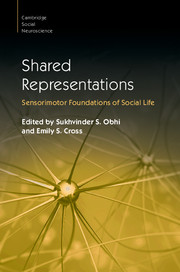Book contents
- Shared Representations
- Cambridge Social Neuroscience
- Shared Representations
- Copyright page
- Contents
- Figures
- Tables
- Boxes
- Contributors
- Preface
- Part I Foundations
- Part II Imitation and Mimicry
- Part III Thinking, Perceiving and Acting with Others
- 10 Levels of Complexity and the Duality of Gaze
- 11 Acting Together
- 12 Joint Perception
- 13 Social Antecedents and Consequences of Behavioral Synchrony
- 14 Musical Ensemble Performance
- Part IV Understanding Others
- Part V Learning and Development
- Part VI Shared Representations in Applied Contexts
- Index
- Plate Section (PDF Only)
- References
12 - Joint Perception
from Part III - Thinking, Perceiving and Acting with Others
Published online by Cambridge University Press: 27 October 2016
- Shared Representations
- Cambridge Social Neuroscience
- Shared Representations
- Copyright page
- Contents
- Figures
- Tables
- Boxes
- Contributors
- Preface
- Part I Foundations
- Part II Imitation and Mimicry
- Part III Thinking, Perceiving and Acting with Others
- 10 Levels of Complexity and the Duality of Gaze
- 11 Acting Together
- 12 Joint Perception
- 13 Social Antecedents and Consequences of Behavioral Synchrony
- 14 Musical Ensemble Performance
- Part IV Understanding Others
- Part V Learning and Development
- Part VI Shared Representations in Applied Contexts
- Index
- Plate Section (PDF Only)
- References
Summary
Perception is solitary. After all, it is the individual alone who feels, hears, tastes, smells and sees. Yet, while the phenomenology of engaging with the world through our senses is restricted to subjective sensations, those sensations are often experienced in a social context. Do social forces change how an individual interacts with the environment and responds to incoming information? We present and discuss a recently discovered phenomenon: people’s eye movements and focus of attention change with their belief that they are looking at objects alone or together with somebody else. Research on ‘joint perception’ provides evidence for the pervasive effect of social context, influencing psychological processes from cognition to low-level perception.
- Type
- Chapter
- Information
- Shared RepresentationsSensorimotor Foundations of Social Life, pp. 236 - 253Publisher: Cambridge University PressPrint publication year: 2016
References
- 1
- Cited by

